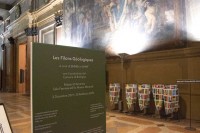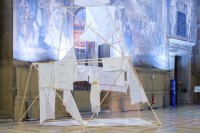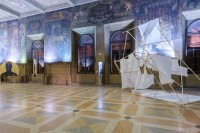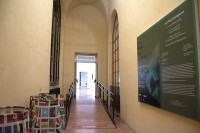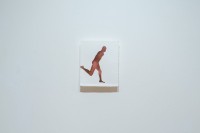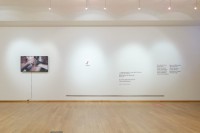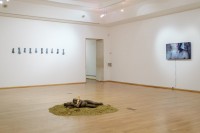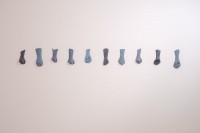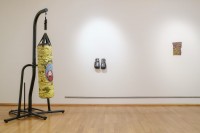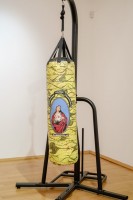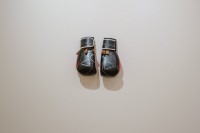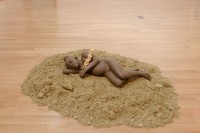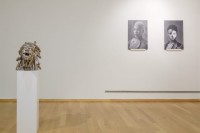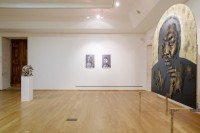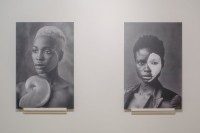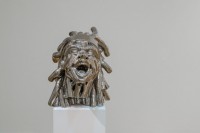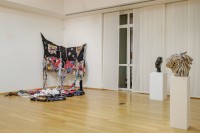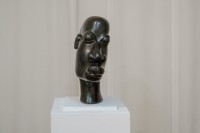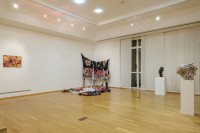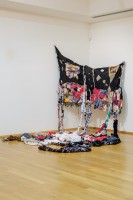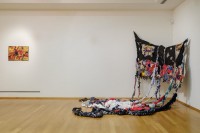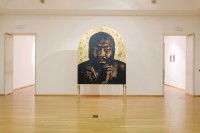ITA
Les Filons Géologiques
A cura di
BHMBo e BHMF
con il contributo del
Comune di Bologna
Palazzo D’Accursio
Sala Farnese
e Sale espositive al secondo piano
3 Dicembre 2021- 20 Febbraio 2022
Artisti:
Clay Apenouvon
Binta Diaw
Delphine Diallo
Victor Fotso Nyie
Senam Okudzeto
Francis Offman
Hyacinthe Ouattara
Bernard Matemera
Muna Mussie
Alexis Peskine
Lerato Shadi
Barthélémy Toguo
George Zogo
Per visite, prenotate a : https://www.eventbrite.com/checkout-external?eid=217837988287
Con Allure, Aime Cesaire invita a meditare su uno spettro temporale che si estende oltre le moderne costruzioni geografiche e l'immaginazione limitata di antenati socialmente prescritti per riflettere su voci antiche come la Terra stessa. In geologia, le vene evidenziano il flusso di fluidi attraverso sistemi di frattura incorporati all'interno di monoliti preistorici. Queste forme a base di minerali del corso favoriscono la comprensione dello stress, della tensione, della pressione, della temperatura, delle origini dei fluidi e della composizione dei fluidi che un tempo scorrevano attraverso la pietra. Discendenza e ascendenza, se intese come un monolite, minano i fluidi psicosociali che informano e modellano tanto quanto erodono e frantumano. Nella seconda edizione di Black History Month Bologna sono stati avviati una serie di conversazioni intorno al tema della geopolitica del corpo. Questa mostra collettiva alimenta i semi piantati attraverso quelle conversazioni.
La mostra inizia nella Sala Farnese con tre opere che evidenziano che il recupero del passato richiede atti di costruzione e ricostruzione della memoria e delle nostre percezioni della persistenza della temporalità. Entrambe le opere di Alexis Peskine, che espandono le sue serie Power Figures e Fire Figures, alludono a nozioni di potenziamento collettivo attraverso incarnazioni rituali e violente della memoria diasporica. Questi ritratti, A Piantare un Chiodo, realizzati con terra fiorentina, chiodi e foglia d'oro durante la residenza dell'artista a Firenze, spostano la nostra percezione da forme individuali a forme collettive della memoria, gesticolando verso la necessità di nuove icone nel contesto italiano in grado di espandere la nostra percezione delle linee temporali dell'ascendenza afrodiscendente in questo ambiente geo-culturale. Con Bologna St. 173 (riverberi) di Muna Mussie, l'artista estende un riverbero della sua mostra personale presentata al termine di una lunga residenza presso Archive Milano: un'installazione modulare vissuta e preformata in un flusso costante. Il progetto attinge a documenti d'archivio e meditazioni personali sul Festival/ Congresso Eritreo di Bologna che ha collettivizzato la diaspora eritrea in raduni annuali di resistenza a sostegno della guerra per l'indipendenza. In commemorazione di questo legame, Bologna Street è stato il nome insignito ad una strada della città di Asmara, capitale dell'Eritrea. Gli elementi presenti nella Sala Farnese sono gli acronimi di una serie di gruppi di resistenza, ricamati su docici netzela, tipico tessuto della tradizione eritrea, drappeggiati su una struttura precaria che rievoca l'idea di rifugio, come forma temporanea di riparo e di casa. Il terzo lavoro in questa sala monumentale è costituito da una serie di cestini realizzati con tessuti che portano le bandiere di una serie di nazioni africane. L'opera, Dustbin, dell’artista acclamato internazionalmente, Barthélémy Toguo, punta allo sfruttamento e all'appropriazione del continente da parte delle potenze "occidentali" e "orientali" come sito di discarica e terra di sfruttamento. L'atemporalità e la ciclicità di queste spoliazioni sono un filo conduttore che ci conduce nello spazio delle Sale espositive del secondo piano.
La serie di opere nelle Sale espositive al secondo piano è suddivisa in due stanze che attraversano generazioni che si intersecano per formare quelle che sono delle contro-narrazioni a una comprensione passiva della storia che interrompe la sua linearità. Lo spazio si apre con un disegno intimo di Senam Okudzeto, Untitled (Particular Subject Advance Concept). L'immagine di una figura senza braccia che fugge verso l'uscita dello spazio è un invito e un'intimazione di ciò che significa avanzare nella fugacità. Motlhaba Wa Re Ke Namile di Lerato Shadi continua questa sezione con una riflessione sulla resistenza con qualsiasi mezzo, anche quelli che portano all'autodistruzione. Il video è basato sulla performance che mostra l'artista che mangia la terra della sua città natale, Lotlhakane. L'opera si riferisce a quegli individui schiavizzati che erano costretti a indossare maschere per sminuire la loro autodeterminazione a causare la propria morte attraverso l'ingerimento di terra. Il gesto richiama le nozioni di libertà attraverso la fuga mortale. Centrale nello spazio è l'opera in ceramica di Victor Fotso Nyie, Guardando le Stelle, in cui una giovane ragazza immersa nel sonno stringe una scultura votiva dorata. L'opera è simultaneamente indicativa di protezione e di fragilità che guarda al futuro, mentre è consapevole di un passato così grintoso come la terra su cui riposa pacificamente. Sulle pareti laterali dello spazio c'è una serie di tre opere, Untitled, di Francis Offman il cui impiego di supporti di recupero evoca un processo pittorico saturo di materialità. Le superfici incrostate di avvallamenti e pieghe d'uso fanno emergere il materiale del caffè come un richiamo alle geografie d'origine transnazionali spesso sottovalutate. Queste opere sono topografie della pratica dell’artista. Istallato in un angolo dello spazio espositivo, il sacco da boxe dipinto da Clay Apenouvon, Sacré Art, è un invito a impegnarsi fisicamente con una dimensione spirituale di resistenza. Guantoni da boxe ornati di talismani fiancheggiano l'immagine di Gesù, in attesa della "prima pietra", con "porgi l’altra guancia" che risuona in dialogo con i motivi da batik che l'artista ha dipinto. La tela Untitled di Georges Zogo parla di un'altra forma di resistenza, resistenza contro le insidie e i pregiudizi che spesso fissano l'arte del continente africano saldamente all'interno delle nozioni di folklore e come antitesi della modernità. I gesti astratti dell'artista e le forme di scrittura automatica sono parte integrante di pratiche che si estendono attraverso un palinsesto di tempo. Quest'opera si trova dall'altra parte della sala rispetto a Black Powerless II di Binta Diaw, la cui disposizione dei pugni inerti di una serie di individui afrodiscendenti basati in Italia mette in discussione il gesto di potere affiliato alle lotte di resistenza. Le sfumature di blu dell'opera convergono le tinture indaco e la storia di un colore associato allo spirito malinconico che ride per non piangere.
La seconda sala si apre con le foto ritratto di Delphine Diallo, Celestial crown serie 1 & Genèse, dove i volti di due donne sono ornati da una pittura bianca che nasconde e protegge queste figure crivellate da contrasti fra morbida e dura, le cui forme organiche raccolgono ed eludono lo sguardo dello spettatore. Queste idee si estendono attraverso altre tre opere figurative di Victor Fotso Nyie con la sua Ribelle, Korekore Head di Bernard Matemera e l'imponente icona di Alexis Peskine. La superficie riflettente di Ribelle consuma lo spazio e riflette lo spettatore. Il platino di quest'opera maschera il suo focus sulla persistenza della rabbia intergenerazionale, mentre la scivolosa pietra serpentina dell'opera di Matemera è impregnata di una silhouette sfuggente senza tempo. L'opera di Peskine, ricoperta di terra e tè all'ibisco, riunisce le possibilità distruttive e redentive dell'attivismo. Un'intricata opera tessile di Hyacinthe Ouattara, Infinito/Materialità, è composta da frammenti di abiti raccolti, legati e cuciti in un'installazione quasi intestinale sviluppata attraverso un workshop all’Accademia Belle Arti di Bologna. Le tracce della storia e il secondo uso di questi materiali puntano verso infinite possibilità e riconoscono i mercati secondari della produzione di abiti. La sala si chiude con una tela Untitled di George Zogo, il cui colore saturo e il cui gesto si ripete nello spazio. Con quest'opera possiamo riflettere su tutti i tentativi di circoscrivere la nerezza e su tutti i modi in cui il pensiero nero ha la capacità di portarci oltre i confini temporali e geografici che lottano per contenerlo.
ING
Les Filons Géologiques
Curated by
BHMBo and BHMF
With a contribution from the
Comune di Bologna
Palazzo D’Accursio
Sala Farnese
and Sale espositive al secondo piano
December 3rd 2021- Februrary 20th 2022
Artists:
Clay Apenouvon
Binta Diaw
Delphine Diallo
Victor Fotso Nyie
Senam Okudzeto
Francis Offman
Hyacinthe Ouattara
Bernard Matemera
Muna Mussie
Alexis Peskine
Lerato Shadi
Barthélémy Toguo
George Zogo
For visits, reserve at: https://www.eventbrite.com/checkout-external?eid=217837988287
With Allure, Aime Cesaire invites a meditation on a temporal spectrum that extends beyond the modern constructions of geographies and the limited imagination of socially prescribed ancestry to reflect upon voices as ancient as the Earth itself. In geology, veins evidence the flow of fluids through fracture systems embedded within prehistoric monoliths. These course mineral-based forms foster insight to stress, strain, pressure, temperature, fluid origins and fluid composition that once flowed through stone. Descent and ancestry, when understood as a monolith, undermine the psycho-social fluids that inform and shape as much as they erode and shatter.
The exhibition begins in the Sala Farnese with three works that highlight the fact that the recovery of the past requires an active construction and reconstruction of memory and of our perceptions of the persistence of temporality. Both works by Alexis Peskine, that expand upon his Power Figures and Fire Figures series, allude notions of collective empowerment through ritual and violent embodiments of diasporic memory. These portraits, A Piantare un Chiodo, realized with Florentine soil, nails and gold leaf during the artists residency in Florence, shift our perception from individual to collective forms of remembering while gesturing towards the need for new icons in the Italian context capable of expanding our perception of the timelines of Black ancestry in this geo-cultural environment. With Muna Mussie’s Bologna St. 173 (riverberi), the artists extends a reverberation of a work developed at the end of an extensive residence at Archive Milano, which was a lived and performed modular installation in constant flux. The project draws upon archival records and personal meditations on the Festival/ Congresso Eritreo di Bologna, collectivizing the Eritrean diaspora in annual resistance gatherings in support of the war for independence. In commemoration of this link, a street of Asmara, the capital of Eritrea, was given the name Bologna Street. One of the key elements present in this installation in Sala Farnese are the acronyms for a range of resistance groups meticulously embroidered into 12 netzelas, traditional Eritrean textiles are draped across a precarious structure, which speaks simultaneously to ideas of refuge, temporary forms of shelter and notions of home. The third work in this monumental space is a series of waste bins realized with fabrics bearing the flags of a range of African nations by internationally acclaimed artist Barthélémy Toguo. The work, Dustbin, points to the exploitation and appropriation of the continent on behalf of “Western” and “Eastern” powers as a site of waste and extrapolation. The timelessness and cyclical nature of these plunderings are a through-line that leads us into the space of the Sale espositivi del secondo piano.
The series of works featured in the Sale espositivi al secondo piano are broken into two rooms that traverse generations intersecting to form counter-narratives to passive understandings of history that disrupt linearity. The space opens with an intimate drawing by Senam Okudzeto, Untitled(Particular Subject Advance Concept). The image of an armless figure fleeing towards the exit of the space is an invitation and an intimation of what it means to advance in fugitivity. Motlhaba Wa Re Ke Namile by Lerato Shadi continues this section speaking to resistance by any means, even those that lead to self-destruction. The performance-based video shows the artist eating the earth from her home-town, Lotlhakane. The work refers to those enslaved individuals who for were forced to wear face masks to keep them from the agency of causing their own demise through the ingestion of dirt. The gesture recalls notions of freedom through mortal flight. Central in the space is the ceramic work by Victor Fotso Nyie, Guardando le Stelle, a young girl deep in sleep clutching a gilded votive sculpture. The work is simultaneously indicative of protection and of fragility looking to the future, while cognizant of a past as gritty as the soil upon which she peacefully rests. On the side walls of the space is a series of three Untitled works by Francis Offman whose employment of reclaimed supports evokes a painterly process saturated with materiality. Surfaces encrusted with the dips and folds of use wrestle the material of coffee to the surface as a reminder of the transnational geographies of origin that are often under-considered. These works are topographies of the artists practice. Installed in a corner of the exhibition space, the painted punching bag by Clay Apenouvon, Sacré Art, sits as an invitation to physically engage with a spiritual dimension of resistance. Boxing gloves adorned with talismans flank the image of Jesus, awaiting “the first stone”, with “turn the other check” echoing in dialogue with the batik based patterns that the artist has painted. The Untitled canvas by Georges Zogo speaks to yet another form of resistance, resistance against the pitfalls and prejudices that frequently fix art from the African continent firmly within notions of folklore and as an antithesis of modernity. The artist’s abstract gestures and forms of automatic writing are part and parcel of practices that extend through a palimpsest of time. This work sits across the room from Black Powerless II by Binta Diaw consists of an arrangement of limp fists cast from a range of Italian based individuals of African descent questions the gesture of empowerment affiliated with resistance struggles. The shades of blues of the piece traverse indigo dyes and the history of a color associated with melancholic spirit that laughs to keep from crying.
The second room opens with the portrait based work of Delphine Diallo, Celestial crown serie 1 & Genèse, where the faces of two women are adorned with white paint that both hides and protects these figures riddled with contrasts of soft and hard edges, whose organic forms collect and evade the viewers gaze. These ideas are extended through three other figurative works by Victor Fotso Nyie with his Ribelle, Bernard Matemera’s Korekore Head and Alexis Peskine’s imposing icon. The reflective surface of Ribelle consumes the space and reflects the viewer. The platinum of this work masks its focus on the persistence of intergenerational rage while the slippery serpentine stone of Matemera’s work is imbued with a timelessly evasive silhouette. Peskine’s work, caked with earth and hibiscus tea, brings together the destructive and redemptive possibilities of activism. A tangled textile work by Hyacinthe Ouattara, Infinito/Materialità, is composed of fragments of clothing gathered, tethered and rebound in an intestinal installation developed through a workshop at the Accademia Belle Arti a Bologna. The traces of history and second use of these materials point towards infinite possibilities and acknowledge the secondary markets for clothing production. The room closes with an Untitled canvas by George Zogo whose saturated color and gesture cycles back through the space. With this work, we can reflect upon all the attempts to circumscribe Blackness, and all of the ways in which Black thought has the capacity to move us beyond the temporal and geographic confines that struggle to contain it.
